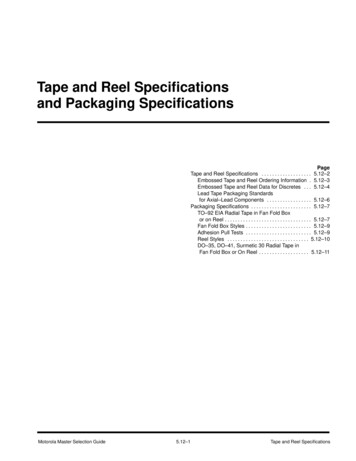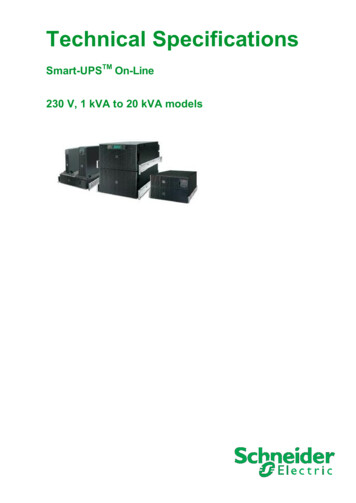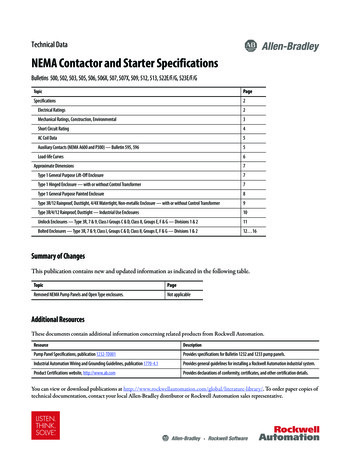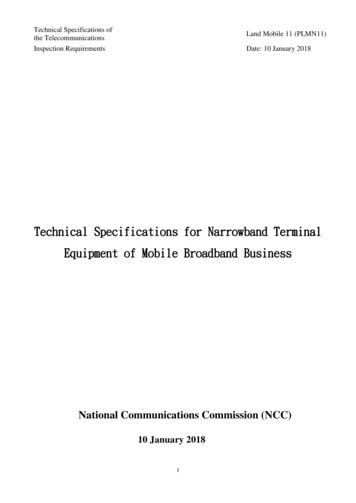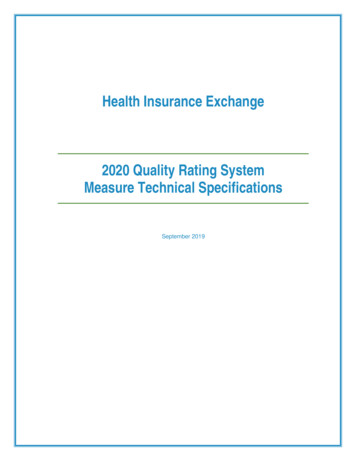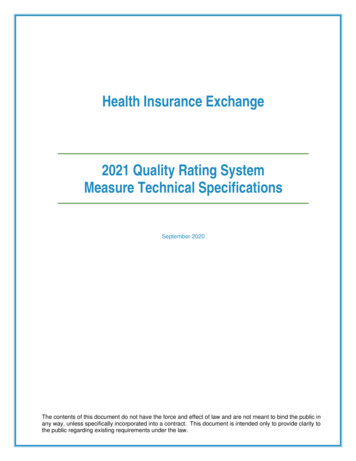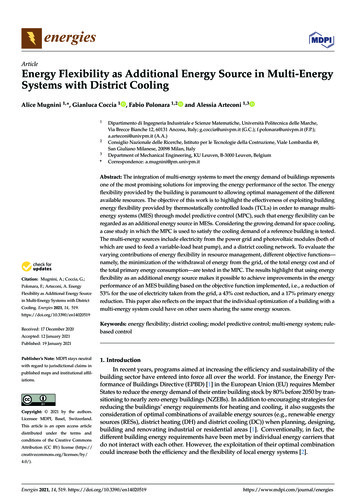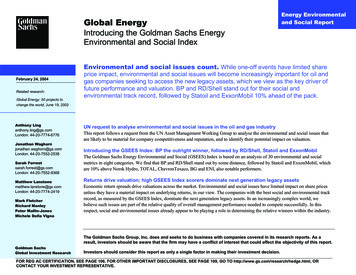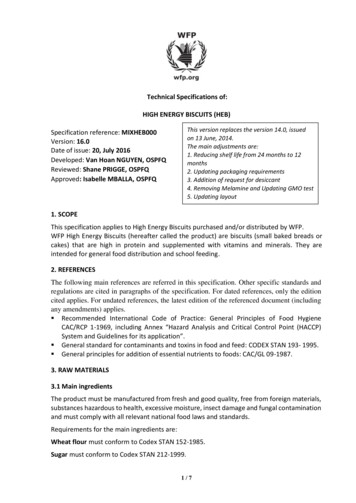
Transcription
Technical Specifications of:HIGH ENERGY BISCUITS (HEB)This version replaces the version 14.0, issuedon 13 June, 2014.The main adjustments are:1. Reducing shelf life from 24 months to 12months2. Updating packaging requirements3. Addition of request for desiccant4. Removing Melamine and Updating GMO test5. Updating layoutSpecification reference: MIXHEB000Version: 16.0Date of issue: 20, July 2016Developed: Van Hoan NGUYEN, OSPFQReviewed: Shane PRIGGE, OSPFQApproved: Isabelle MBALLA, OSPFQ1. SCOPEThis specification applies to High Energy Biscuits purchased and/or distributed by WFP.WFP High Energy Biscuits (hereafter called the product) are biscuits (small baked breads orcakes) that are high in protein and supplemented with vitamins and minerals. They areintended for general food distribution and school feeding.2. REFERENCESThe following main references are referred in this specification. Other specific standards andregulations are cited in paragraphs of the specification. For dated references, only the editioncited applies. For undated references, the latest edition of the referenced document (includingany amendments) applies. Recommended International Code of Practice: General Principles of Food HygieneCAC/RCP 1-1969, including Annex “Hazard Analysis and Critical Control Point (HACCP)System and Guidelines for its application”. General standard for contaminants and toxins in food and feed: CODEX STAN 193- 1995. General principles for addition of essential nutrients to foods: CAC/GL 09-1987.3. RAW MATERIALS3.1 Main ingredientsThe product must be manufactured from fresh and good quality, free from foreign materials,substances hazardous to health, excessive moisture, insect damage and fungal contaminationand must comply with all relevant national food laws and standards.Requirements for the main ingredients are:Wheat flour must conform to Codex STAN 152-1985.Sugar must conform to Codex STAN 212-1999.1/7
Shortening must be prepared from oil that conform to Codex STAN 210-1999, must be freefrom trans fatty acids and must contain only antioxidants that comply with Codex and relevantregulations.Skimmed milk powder must conform to Codex STAN 207-1999. It must be accompanied by a ‘melamine-free’ certificate. Maximum level aflatoxin M1: 0.5 mcg/kg milk (recommended methods ISO 14501/IDF171:20071 or ISO 14674/IDF 190:20052).Other raw materials and additives (if used) must comply with Codex or relevant regulations.Raw materials must be stored under dry, ventilated and hygienic conditions. Only safeinsecticides (i.e. phosphine) may be used for fumigation control. Where needed, fumigationmust be performed by certified operators.3.2 Vitamins and mineralsComplete micronutrient premix must be purchased from GAIN Premix Facility or any of theGAIN approved suppliers. A complete list of suppliers is available at the following uppliersMicronutrient premix must be delivered to the processor of the product with a completeCertificate of Analysis and a Proof of purchase. The two documents must be presented withother documents to WFP for payment.Micronutrient premix must be stored in a dry, cool and clean place.4. PROCESSING4.1 FormulaThe product formulation shall be based on supplier experience and must include: Dry Skimmed Milk: Min. 4 g/100g of biscuit Sugar: 10-19 g/100g of biscuit.Note: soybean and soybean derivatives are not authorized.4.2 Homogeneity of micronutrientsTheoretical calculations indicate that a mixing system with a Coefficient of Variation of 10%using iron as the indicator element, will enable product to meet the above variation target on95%, provided that all conditions of mixing are rigorously applied. The guide for thiscalculations is showed at http://foodqualityandsafety.wfp.org4.3 Food safety and risk assessment at manufacturing premisesFor compliance with Codex standards the processor must be able to demonstrate by principleand practice the adoption, implementation and recording of: Good Manufacturing Practices Hazard Analysis Critical Control Point programIn this context an appointed WFP Inspector / Quality Surveyor is entitled to visit the factorywithout prior notice during any period when WFP product is being manufactured to check1Milk and milk powder: determination of aflatoxin M1 content, clean up by immunoaffinity chromatographyand determination by HPLC.2Milk and milk powder: determination of aflatoxin M1 content, clean up by immunoaffinity chromatographyand determination by Thin Layer Chromatography.2/7
that the GMP and HACCP systems are in place. The Inspector / Quality Surveyor may requestto see: Records (i.e. names of people in charge of the process and quality control, temperaturesof the process, mixing times / quantity, cleaning schedules, etc). Procedures (e.g. cleaning, personnel hygiene, HACCP, sampling and analysis). Instructions (e.g. process instructions, cleaning instructions). The quality manual for the process or factory.The manufacturer must be registered under national food law as a processor of foods forhuman consumption.5. PRODUCT SPECIFICATIONS5.1 General requirements5.1.1 Contaminants5.1.1.1 Heavy metalsThe product shall be free from heavy metals in amounts which may represent a hazardto health.5.1.1.2 Pesticide residuesThe product shall comply with those maximum residue limits established by the CodexAlimentarius Commission for this commodity.The product shall be prepared with special care under good manufacturing practices,so that residues of those pesticides which may be required in the production, storageor processing of the raw materials or the finished food ingredient do not remain, or,if technically unavoidable, are reduced to the maximum extent possible.These measures shall take into account the specific nature of the products concernedand the specific population group for which they are intended.5.1.1.3 MycotoxinsThe product shall comply with those maximum mycotoxin limits established by theCodex Alimentarius Commission for this commodity.The maximum level of aflatoxin M1 is less than 0.5 ppb.5.1.1.4 Other contaminantsThe product shall be free from residues of hormones, antibiotics as determined bymeans of agreed methods of analysis and practically free from other contaminants,especially pharmacologically active substances.5.1.2 Hygiene5.1.2.1 It is recommended that the products covered by the provisions of this standard beprepared and handled in accordance with the appropriate sections of theRecommended International Code of Practice – General Principles of Food Hygiene(CAC/RCP 1-1969), and other Codes of Practice recommended by the CodexAlimentarius Commission which are relevant to these products.5.1.2.2 The product should comply with any microbiological criteria established in accordancewith the Principles for the Establishment and application of microbiological Criteriafor Foods (CAC/GL 21-1997)3/7
5.1.2.3 To the extent possible in good manufacturing practice, the products shall be free fromobjectionable matter.5.1.2.4 When tested by appropriate methods of sampling and examination, the products:– shall be free from micro-organisms in amounts which may represent a hazard tohealth;– shall be free from parasites which may represent a hazard to health; and– shall not contain any substance originating from micro-organisms in amounts whichmay represent a hazard to health.5.1.3 Fit for human consumption guaranteeSuppliers shall have to check the quality of their products and guarantee that the product is‘fit for human consumption’.5.2 Specific requirements5.2.1 FortificationThe product must be fortified to provide the following net micro nutrient supplement per100g of biscuit (table 1).Table 1: Micronutrient rate and chemical formVitamin A-RetinolVitamin B1Vitamin B2NiacinPantothenic acidVitamin B6Folic acidVitamin B12Vitamin CVitamin DVitamin ECalciumMagnesiumIronIodineTarget250 µg0.5 mg0.7 mg6 mg3 mg1 mg80 µg2 µg20 mg1.9 µg5 mg250 mg150 mg11 mg75 µgChemical formPalmitate 250 CWSThiamine mononitrateRiboflavinNicotinamideCalcium d-pantothenatePyridoxin hydrochlorideFolic acidVitamin B12 – 1% in manitolAscorbic acid coatedVit D3 100 CWSVit E 50 CWSCalcium carbonateAs magnesium oxideFerrous fumaratePotassium iodateNote: Variable levels of micronutrients (i.e. iron, zinc, calcium etc.) naturally present in rawmaterials may lead variable of micronutrients in finished product.5.2.2 Biscuit characteristicThe product must be free of insect (all stages, dead or live). Unless otherwise specified in thecontract, one biscuit should weigh between 5 g and 10g.The product must also comply with other requirements specified in table 2.4/7
5.2.3 Shelf lifeUnless stated otherwise in the contractual agreement, the product must have minimum 12months shelf life when stored up to 30 C.6. PACKAGINGThe product covered by the provision of this specification must be packed in appropriatepackaging which safeguard the hygienic, nutritional, technological, and organoleptic qualitiesof the product. The containers, including packaging material, shall be made of substanceswhich are safe and suitable for their intended use. They should not impart any toxic substanceor undesirable odour or flavour to the product.6.1 Primary packageUnless otherwise specified in the contract, the product must be packed in new uniform strongpackage, fit for export and multiple handing and must be hermetically heat-sealed. Unlessotherwise specified in the contract, each package must contain 50 grams, 75 grams, 100 gramsor 250 grams biscuits (as per specified in the contract). The package must comply with belowrequirements: It must be based on supplier experience and comply with relevant regulations. It must be food grade, have good sealing properties and be printed as per requirement. It must include a metalized layer to reduce permeability to Oxygen and Vapor. It must be stored under dry, ventilated and hygienic conditions.Typically a laminated composed of BOPP VMCPP (20 and 25 microns respectively) orequivalent or stronger can be used.6.2 Secondary packageIndividual packages must be stuffed in strong cardboard cartons suitable for multiple handlingand must contain as per contractual agreement from 10 kg to15 kg Net biscuits.The cartons used to pack the primary packaging of the products shall be fit for export andmultiple-harsh handing. The cartons for 15kg of products (including primary packaging) shouldmeet the following requirements:- Number of ply: 5- Total grammage: MIN. 870 gsm- Edge Crush Test: MIN. 12 kN/mCarton must be fully filled and glued. Secondary packaging (i.e. cartons with full product) mustpass the drop test as per ISTA 2A standard (after each drop, there shall be no rupture or lossof contents).Unless otherwise specified in the contract, two percent empty, marked cartons (included inthe price) must be sent with the lot.Unless fully shrink wrapped pallets are used, dunnage (of strong sheets such as carton,plywood ) should be placed inside each container at every three layers of cartons to providethe required stacking strength. In addition protecting material like air bag, carton, polystyrene,can be used.Note: For shipping containers, unless fully shrink wrapped pallet are used, and unlessotherwise specified in the contract, kraft paper must be adhered to all internal sides, door, andfloor of container. Kraft paper also need to be placed on the top of packaging. Desiccant needs5/7
to be placed/laid in container at appropriate location in order to absorb moisture. Supplierneeds to use high quality desiccant and calculate the quantity of desiccant based on:- Efficiency of desiccant- Length of time in transit in container- Container capacitySupplier needs to provide in the offer the type of desiccant and quantity to be used for theconsignment. If silica gel is used, 15 bags of at least 1 kg each must be placed in each 20 feetcontainer.7. MARKINGThe labelling of the product covered by the provision of this specification shall comply withCODEX STAN 1-1985.Primary packages (of 50 grams, 75 grams, 100 grams or 250 grams biscuits) must be printedwith the following information in a visible way: Product name : “ High Energy Biscuits” World Food Programme WFP logo Donor marking as per contractual agreement Ingredient list Nutritional information per 100 g “This product contains no lard” “Not for sale” Net weight Best before end : month year Production lot Country of origin Name and address of the vendorAdditional marking is as per contractual agreement.Cartons must be printed with the following information in a visible way: Product name: “ High Energy Biscuits” World Food Programme (in letters of 5 cm) WFP logo Donor marking as per contractual agreement Net weight (total net weight of all primary packages in the carton) Best before end : month year Production lot Country of origin Name and address of the vendorAdditional marking is as per contractual agreement.8. STORINGThe product must be stored under dry, ventilated and hygienic conditions and far from allsource of contaminations. Ideally, the product should be stored up to 30 C.9. ANALYTICAL REQUIREMENTSUnless otherwise decided by WFP, the principal tests in table 1 are performed by WFPappointed inspection company/ laboratory and the results of the tests shall be used for lot6/7
release decision. If the laboratory results indicate at least a parameter doesn’t comply withWFP specification, only WFP can decide whether or not the lot can be accepted. Additionaltests may be defined in case of further quality assessment is required. Supplier/processorshould also conduct internal tests to make sure that the quality of the product meets WFPrequirements.Table 2: List of compulsory tests and reference methodNo TestsRequirements13Broken biscuits456789ProteinFatSugar (total)Crude fibreAsh (total)Aflatoxin M1Max 4.5 %Typical color, Pleasant smelland palatable taste.Max. 5.0 % broken (byweight)Min. 9 g/100gMin. 15.0 g/100g10.0-19.0 g/100gMax. 2.3 g/100gMax. 3.5 g/100g 0.5 ppb10Peroxide valueMax. 10 meq/kg fatAOAC 965.331112Vitamin A-RetinolIronAerobic mesophillicbacteriaColiformsEscherichia coliSalmonellaStaphylococcus aureusBacillus cereusYeasts and mouldsGMO cereal(Only ifrequired)Min. 250 mcg/100gMin. 11 mg/100gAOAC 960.45AOAC 945.40ICC No 125AACC 42-11AOAC 2005.03AOAC 991.14AACC 42-25BAACC 42-30BAOAC 980.31ICC No 146Quantitative PCRISO 2157021314151617181920Moisture contentOrganoleptic (smell,taste, color)Reference method (orequivalent, latest version)AOAC 925.10, 2002Max. 10,000 cfu/gMax. 10 cfu/gAbsent in 10 gAbsent in 25 g 10 cfu/gMax. 10 cfu/gMax. 100 cfu/g 0.9 % of GMO material intotal cereal DNA7/7SensoryVisual inspectionAOAC 981.10AOAC 963.15, 2000AOAC 920.189AOAC 962.09ISO 2171.2000AACC 45-16
The product must be fortified to provide the following net micro nutrient supplement per 100g of biscuit (table 1). Table 1: Micronutrient rate and chemical form Target Chemical form Vitamin A-Retinol 250 µg Palmitate 25
